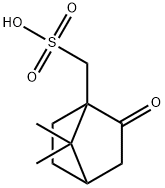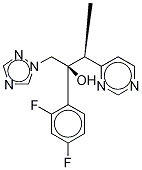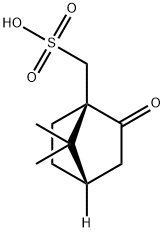DL-10-CAMPHORSULFONIC ACID
Synonym(s):(±)-β-Camphorsulfonic acid;(±)-Camphor-10-sulfonic acid;CSA
- CAS NO.:5872-08-2
- Empirical Formula: C10H16O4S
- Molecular Weight: 232.3
- MDL number: MFCD00074827
- EINECS: 227-527-0
- SAFETY DATA SHEET (SDS)
- Update Date: 2025-12-17 09:49:46

What is DL-10-CAMPHORSULFONIC ACID?
Chemical properties
DL-10-CAMPHORSULFONIC ACID is white to off-white powder
The Uses of DL-10-CAMPHORSULFONIC ACID
(+)-Camphor-10-sulfonic acid is used as a resolving agent for chiral amines and other cations. It is involved in the preparation of active pharmaceutical ingredient such as trimetaphan camsilate, which is used to reduce bleeding during neurosurgery. Further, it is involved in the transglucosidation of methyl and ethyl D-glucopyranosides by alcoholysis.
Definition
ChEBI: Camphorsulfonic acid is a sulfonic acid containing the camphorsulfonate anion. It is functionally related to a camphor. It is a conjugate acid of a camphorsulfonate anion.
General Description
Camphorsulfonic acid is a organosulphur compound.
Properties of DL-10-CAMPHORSULFONIC ACID
| Melting point: | 203-206 °C (dec.)(lit.) |
| Boiling point: | 344.46°C (rough estimate) |
| alpha | [α]D20 0.0±0.3° (c=5, H2O) |
| Density | 1.2981 (rough estimate) |
| refractive index | 1.5400 (estimate) |
| storage temp. | 2-8°C |
| form | Granular Powder |
| pka | 1.17±0.50(Predicted) |
| color | Slightly beige |
| Water Solubility | Soluble in water. |
| Sensitive | Hygroscopic |
| BRN | 3205973 |
| Stability: | Stable. Incompatible with strong bases, strong oxidizing agents. Combustible. |
| CAS DataBase Reference | 5872-08-2(CAS DataBase Reference) |
| EPA Substance Registry System | Bicyclo[2.2.1]heptane-1-methanesulfonic acid, 7,7-dimethyl-2-oxo- (5872-08-2) |
Safety information for DL-10-CAMPHORSULFONIC ACID
| Signal word | Danger |
| Pictogram(s) |
 Corrosion Corrosives GHS05 |
| GHS Hazard Statements |
H314:Skin corrosion/irritation |
| Precautionary Statement Codes |
P260:Do not breathe dust/fume/gas/mist/vapours/spray. P280:Wear protective gloves/protective clothing/eye protection/face protection. P301+P330+P331:IF SWALLOWED: Rinse mouth. Do NOT induce vomiting. P303+P361+P353:IF ON SKIN (or hair): Remove/Take off Immediately all contaminated clothing. Rinse SKIN with water/shower. P305+P351+P338:IF IN EYES: Rinse cautiously with water for several minutes. Remove contact lenses, if present and easy to do. Continuerinsing. |
Computed Descriptors for DL-10-CAMPHORSULFONIC ACID
| InChIKey | MIOPJNTWMNEORI-UHFFFAOYSA-N |
New Products
4,4-Difluoropiperidine hydrochloride tert-butyl 9-methoxy-3-azaspiro[5.5]undecane-3-carboxylate Indole Methyl Resin N-Isopropylurea N,N-Dicyclohexylcarbodiimide(DCC) MELDRUMS ACID 5-METHYLISOXAZOLE-4-CARBOXYLIC ACID Magnessium Bis glycinate Zinc ascorbate 1-bromo-2-butyne 2-acetamidophenol 9(10H)-anthracenone Erythrosin B, 4-Piperidinopiperidine 2-((4-morpholinophenylamino) (methylthio) methylene) malononitrile 2,4-dihydroxybenzaldehyde 3-(4-morpholinophenylamino)-5-amino-1H-pyrazole-4-carbonitrile Methyl 2-methylquinoline-6-carboxylate 2,6-dichloro-4-nitropyridine 4-Bromo-2-chlorobenzonitrile 2-(benzylamino)acetic acid hydrochloride 4-(tert-Butoxycarbonylamino)but- 2-ynoic acid 3,4-dihydro-2H-benzo[b][1,4]dioxepine 1-Phenyl-1-cycloprppanecarboxylicacidRelated products of tetrahydrofuran




![methyl N,N,N-trimethyl-4-[(4,7,7-trimethyl-3-oxobicyclo[2.2.1]hept-2-ylidene)methyl]anilinium sulphate](https://img.chemicalbook.in/CAS/GIF/52793-97-2.gif)



You may like
-
 5872-08-2 (+/-)-10-Camphorsulfonic Acid 98%View Details
5872-08-2 (+/-)-10-Camphorsulfonic Acid 98%View Details
5872-08-2 -
 (±)-10-Camphorsulfonic Acid CAS 5872-08-2View Details
(±)-10-Camphorsulfonic Acid CAS 5872-08-2View Details
5872-08-2 -
 DL-10-camphorsulfonic acid 98% CAS 5872-08-2View Details
DL-10-camphorsulfonic acid 98% CAS 5872-08-2View Details
5872-08-2 -
 Camphorsulfonic Acid Liquid CAS 5872-08-2View Details
Camphorsulfonic Acid Liquid CAS 5872-08-2View Details
5872-08-2 -
 Voriconazole Related Compound F CAS 5872-08-2View Details
Voriconazole Related Compound F CAS 5872-08-2View Details
5872-08-2 -
 Camphor-10-sulfonic acid (β) CAS 5872-08-2View Details
Camphor-10-sulfonic acid (β) CAS 5872-08-2View Details
5872-08-2 -
 20677-73-0 (2,2-diethoxyethyl)methylamine 98%View Details
20677-73-0 (2,2-diethoxyethyl)methylamine 98%View Details
20677-73-0 -
 3-(4-(hydroxyamino)-1-oxoisoindolin-2-yl)piperidine-2,6-dione 98%View Details
3-(4-(hydroxyamino)-1-oxoisoindolin-2-yl)piperidine-2,6-dione 98%View Details
Statement: All products displayed on this website are only used for non medical purposes such as industrial applications or scientific research, and cannot be used for clinical diagnosis or treatment of humans or animals. They are not medicinal or edible.
